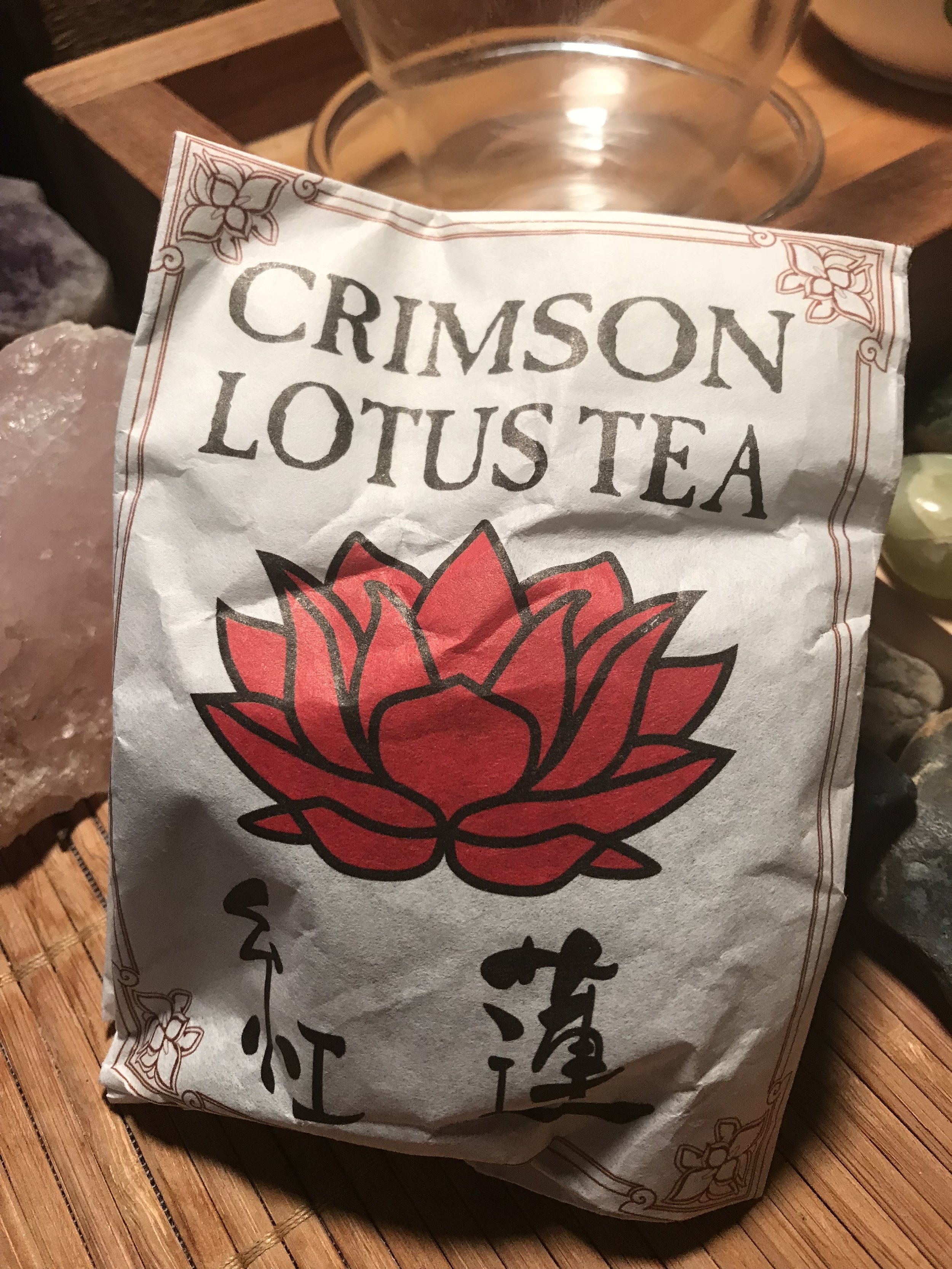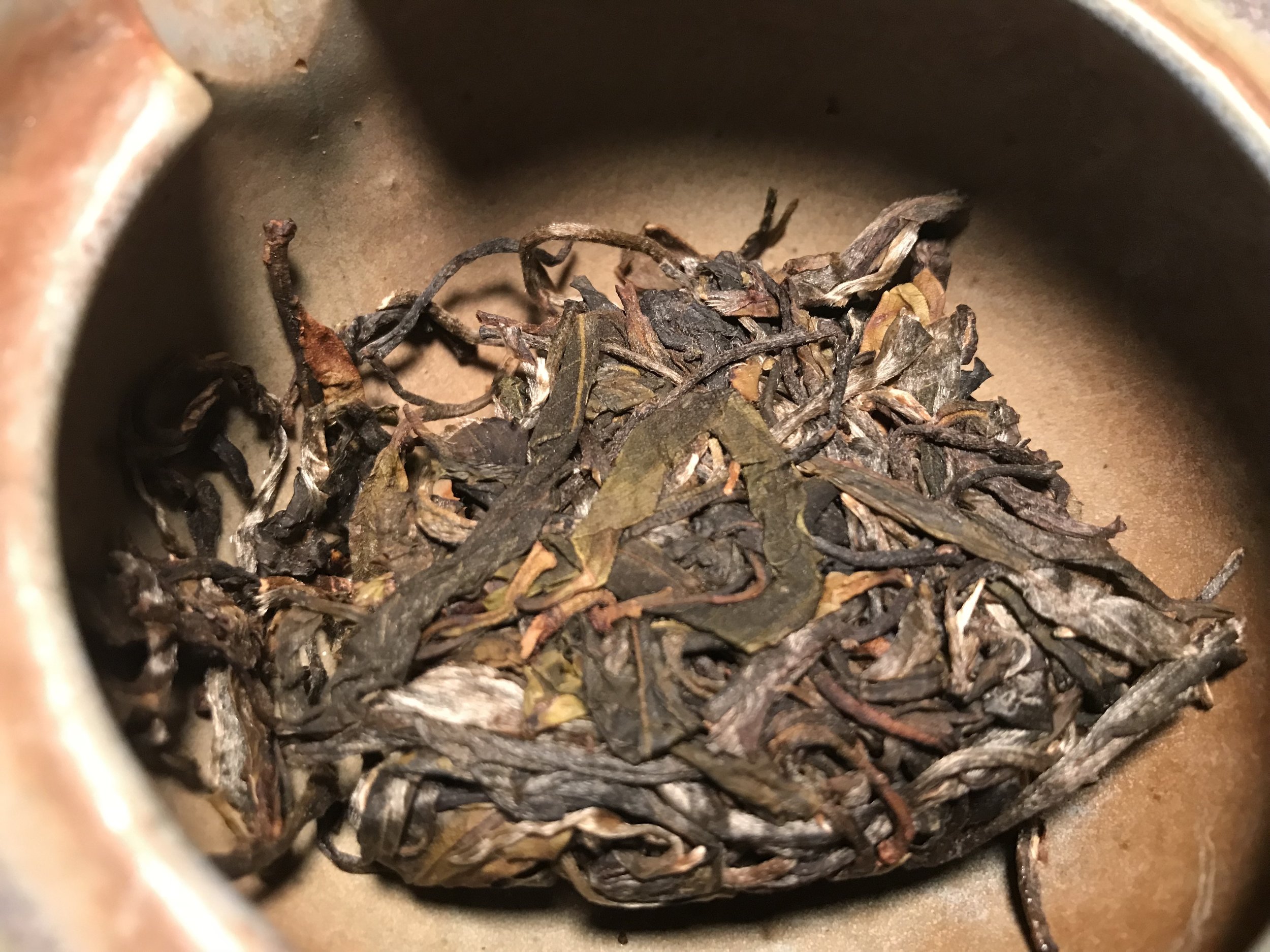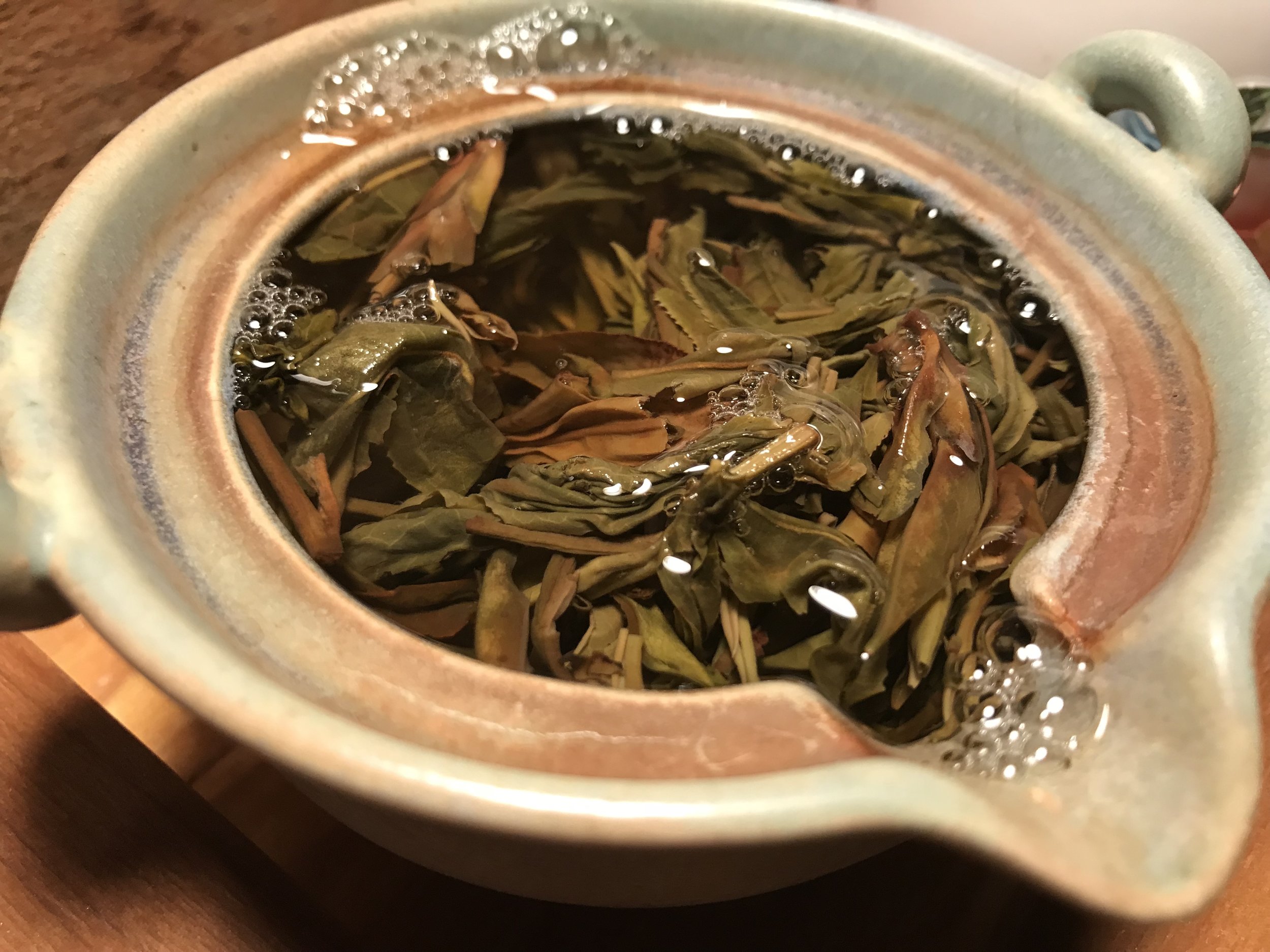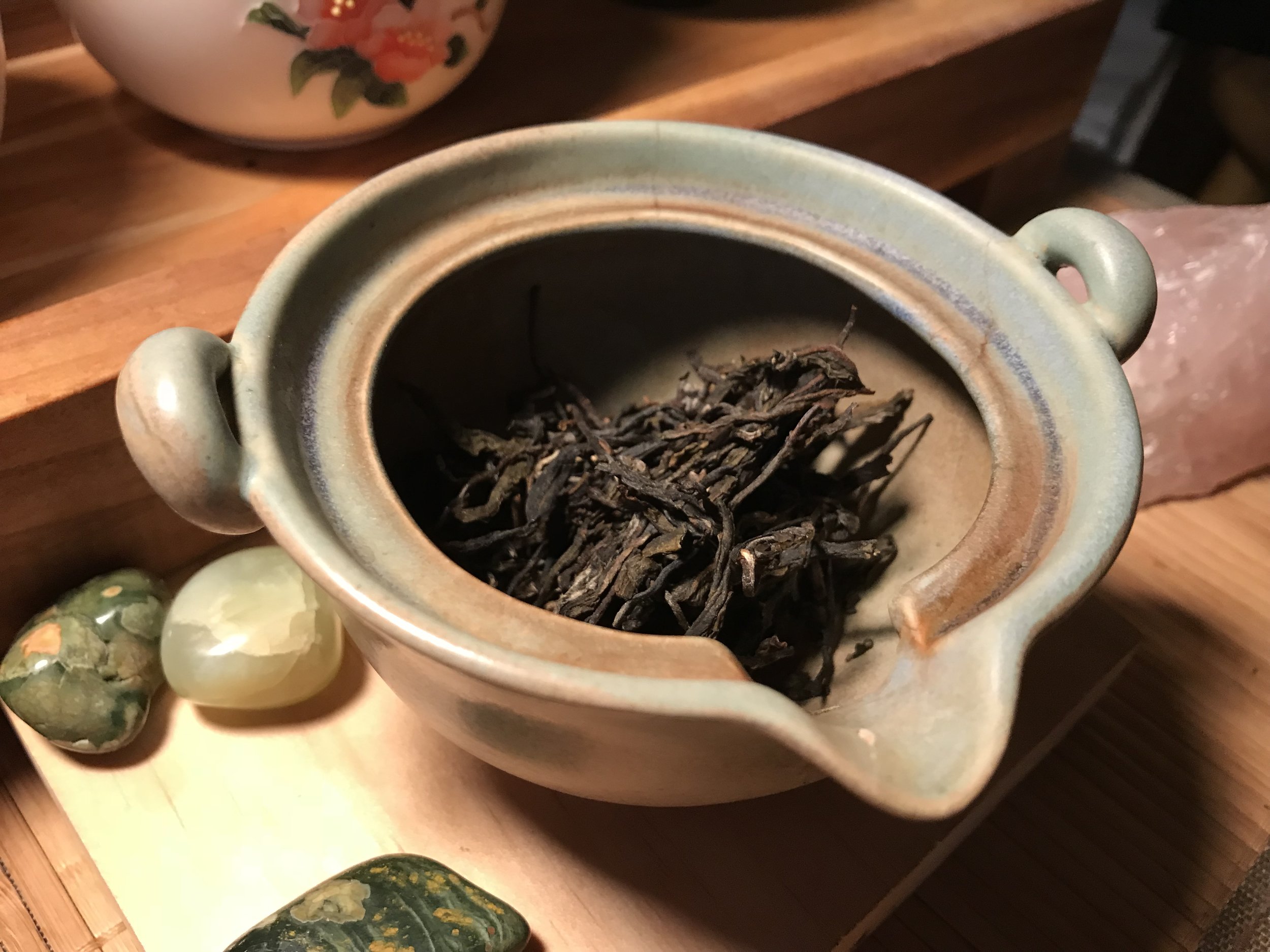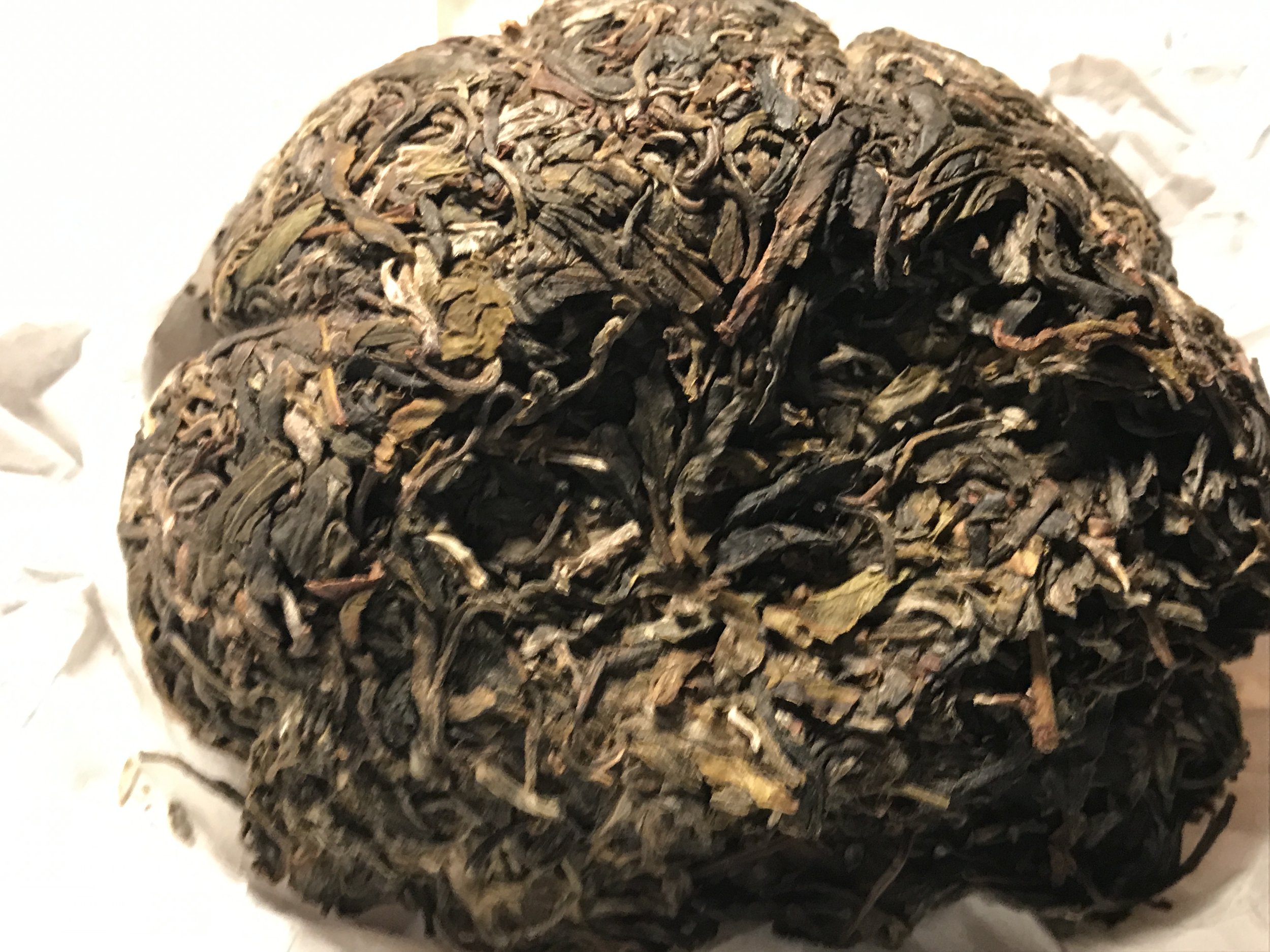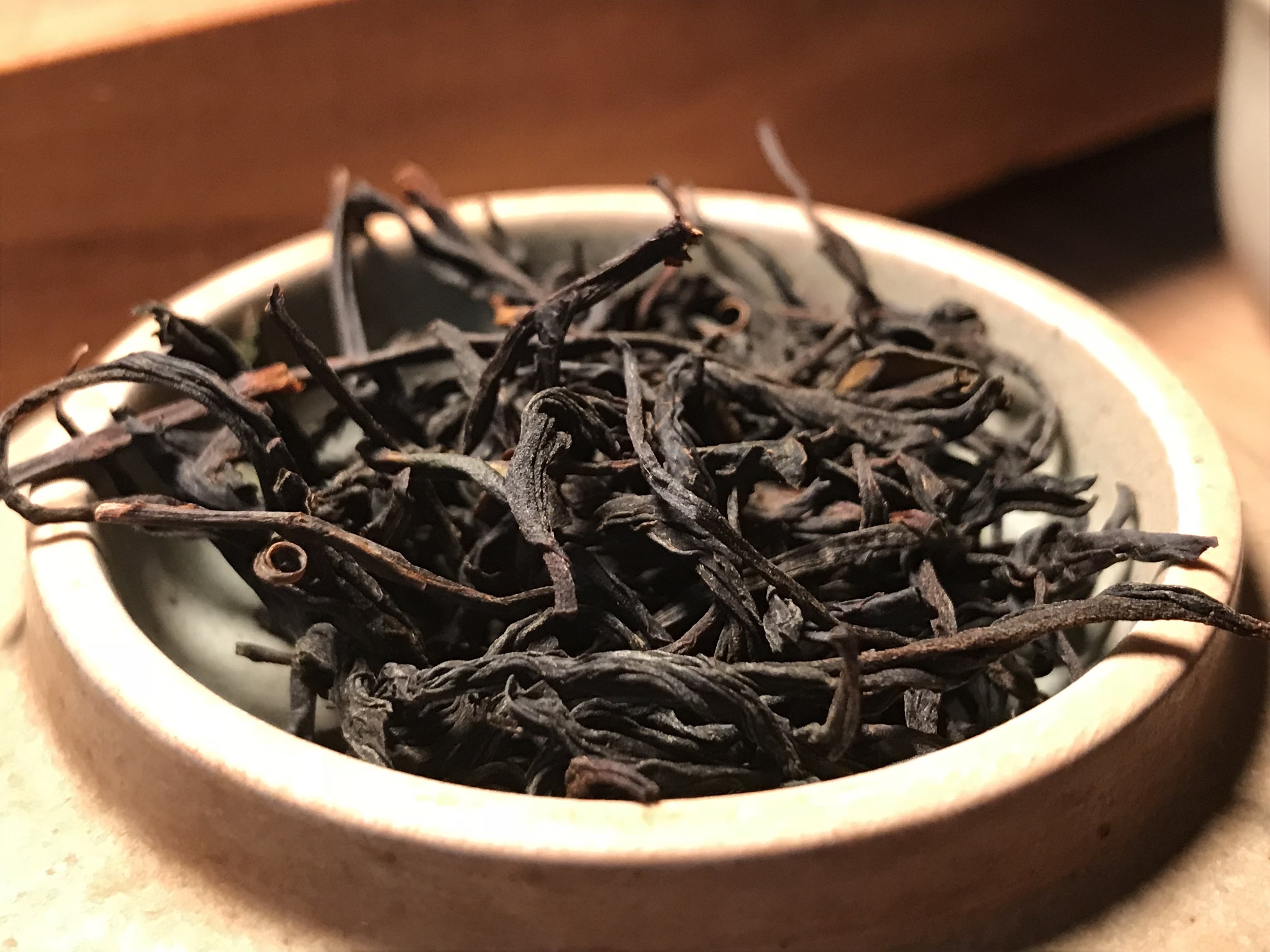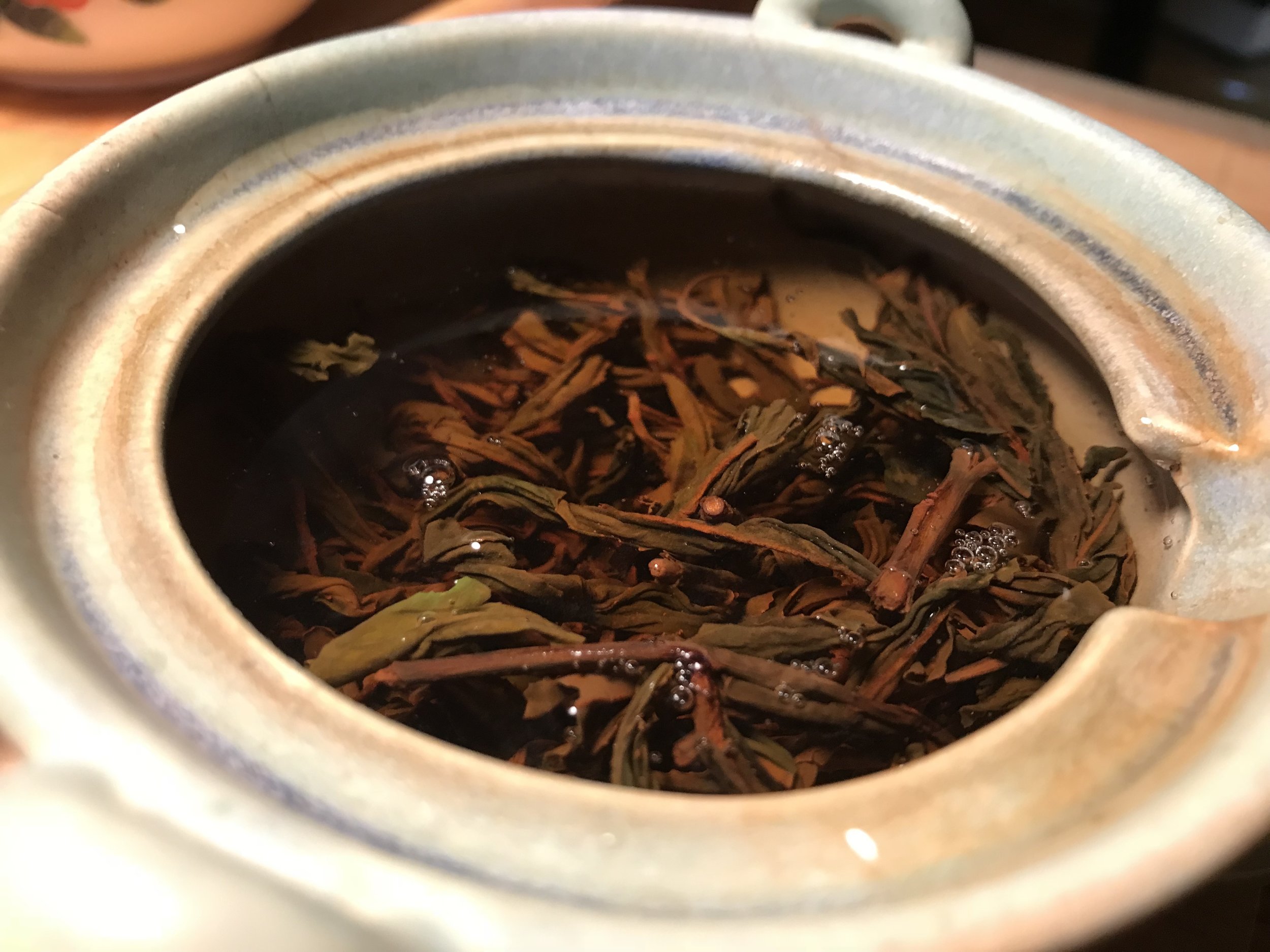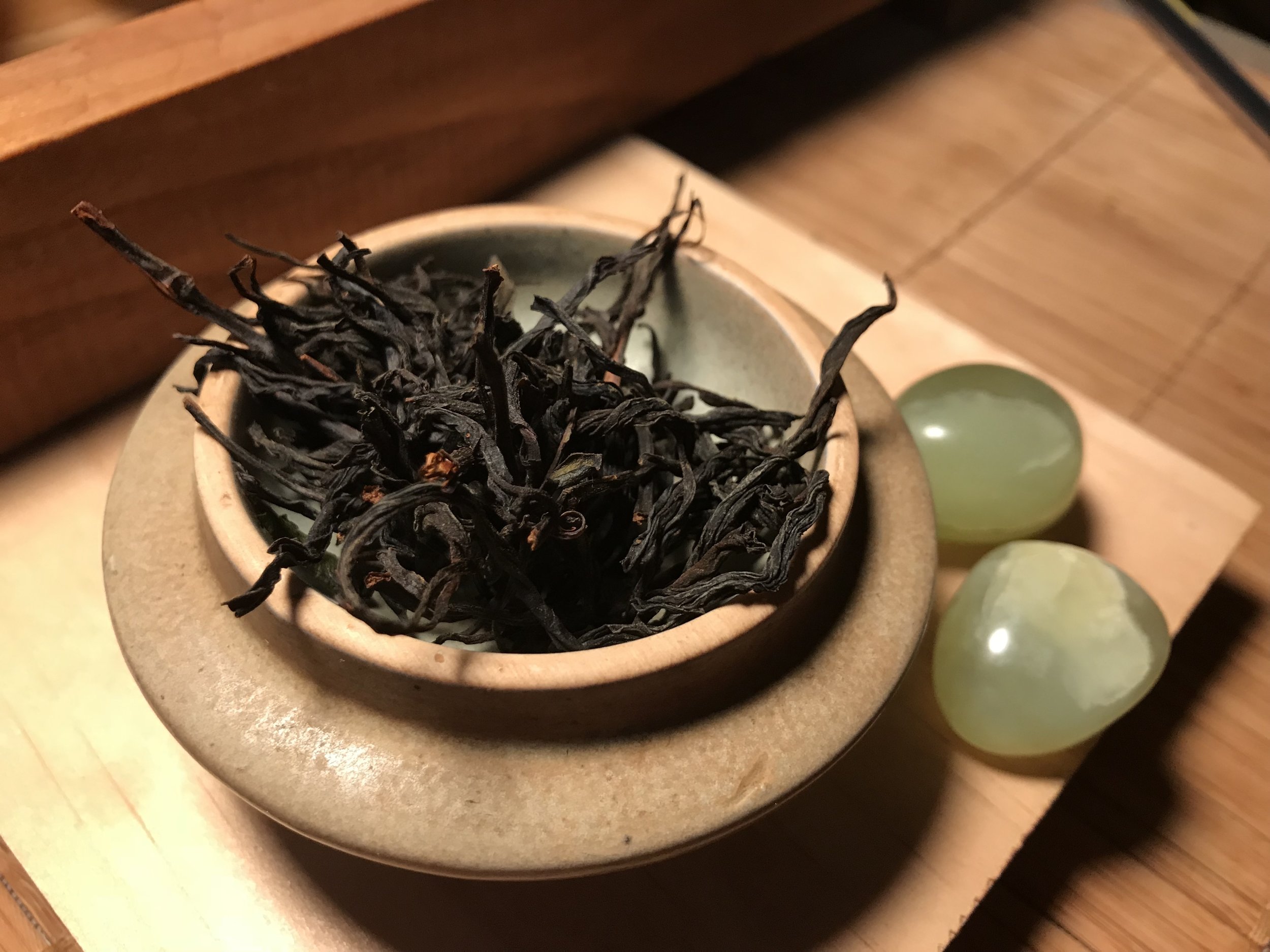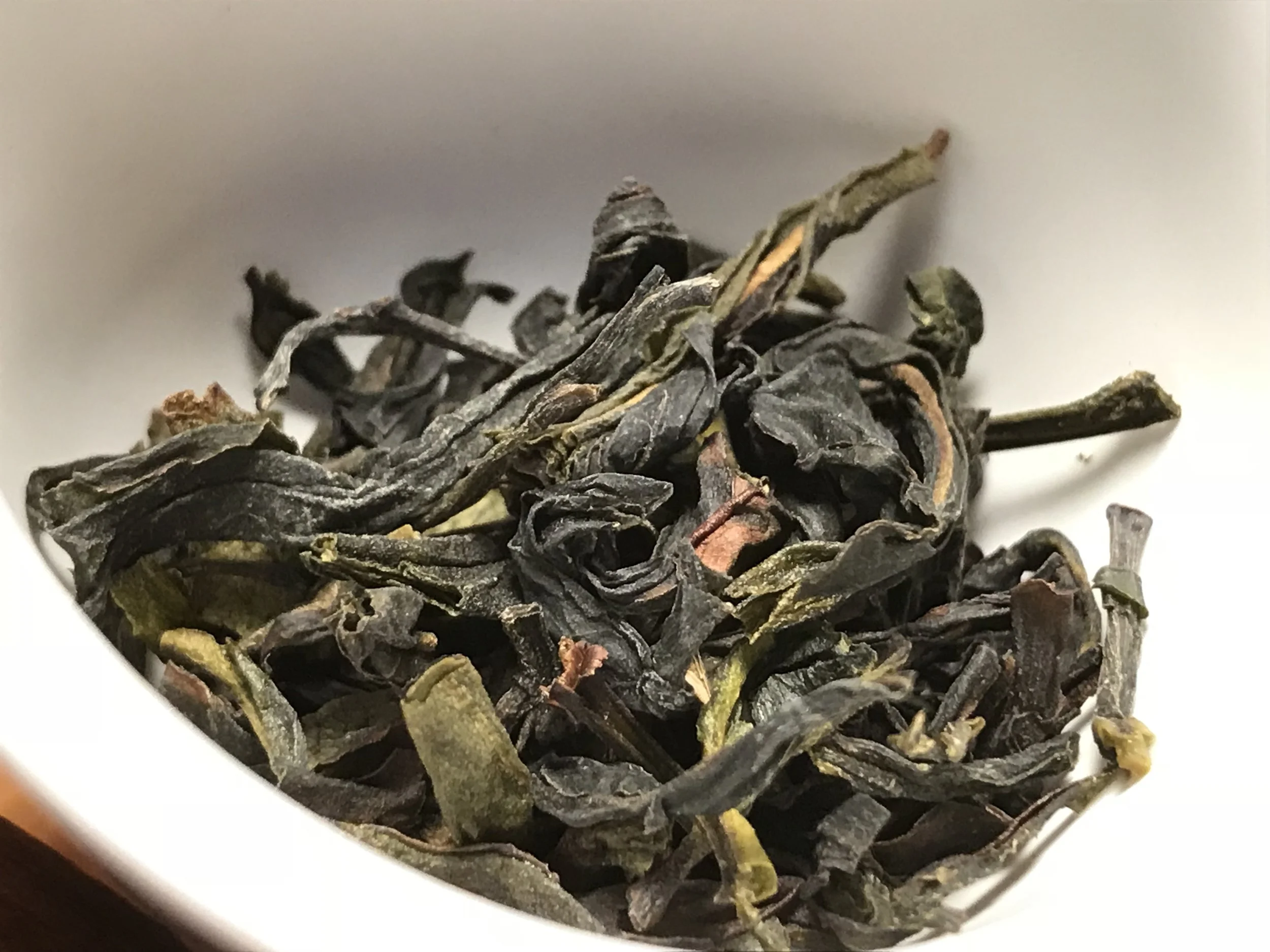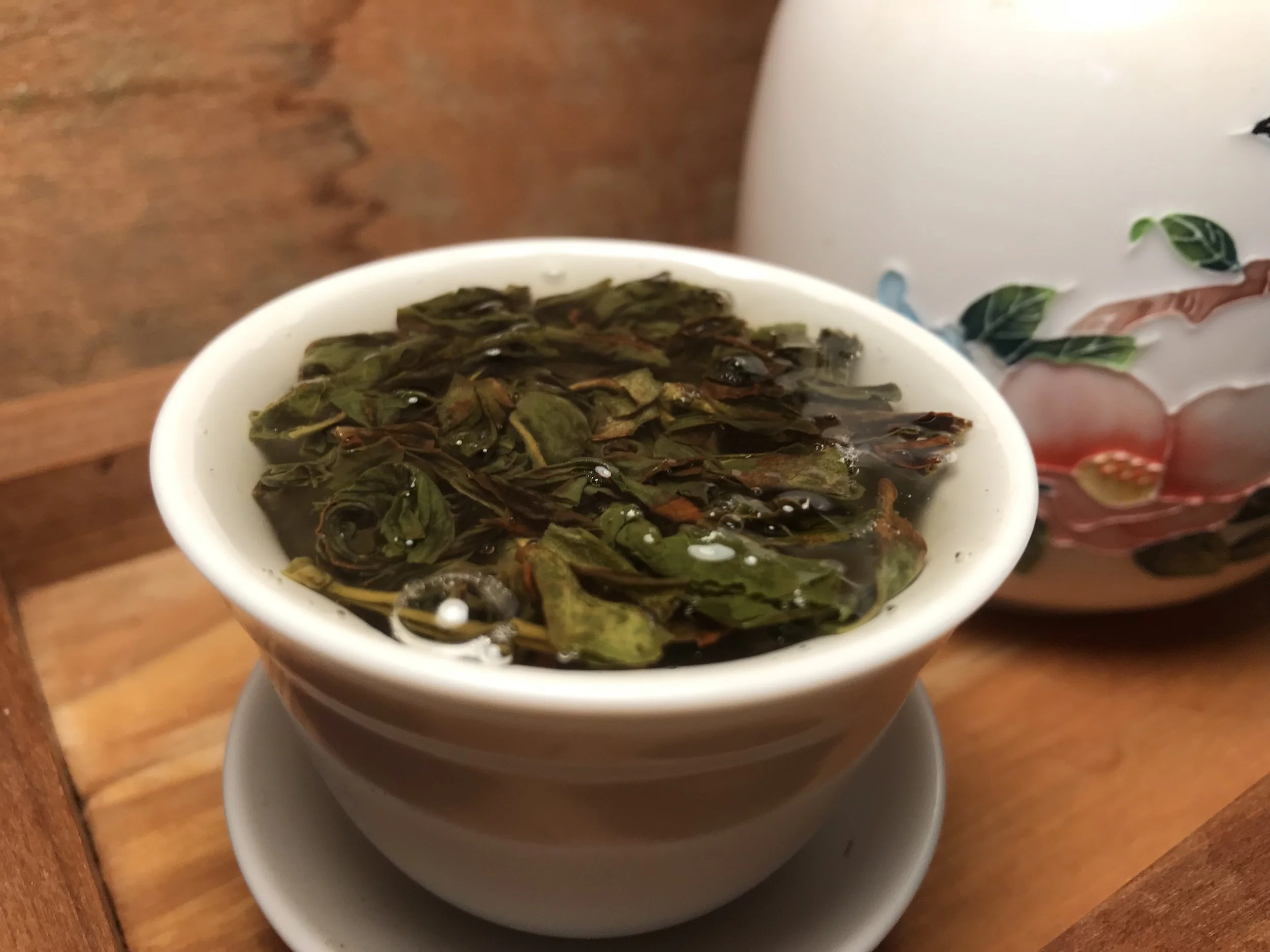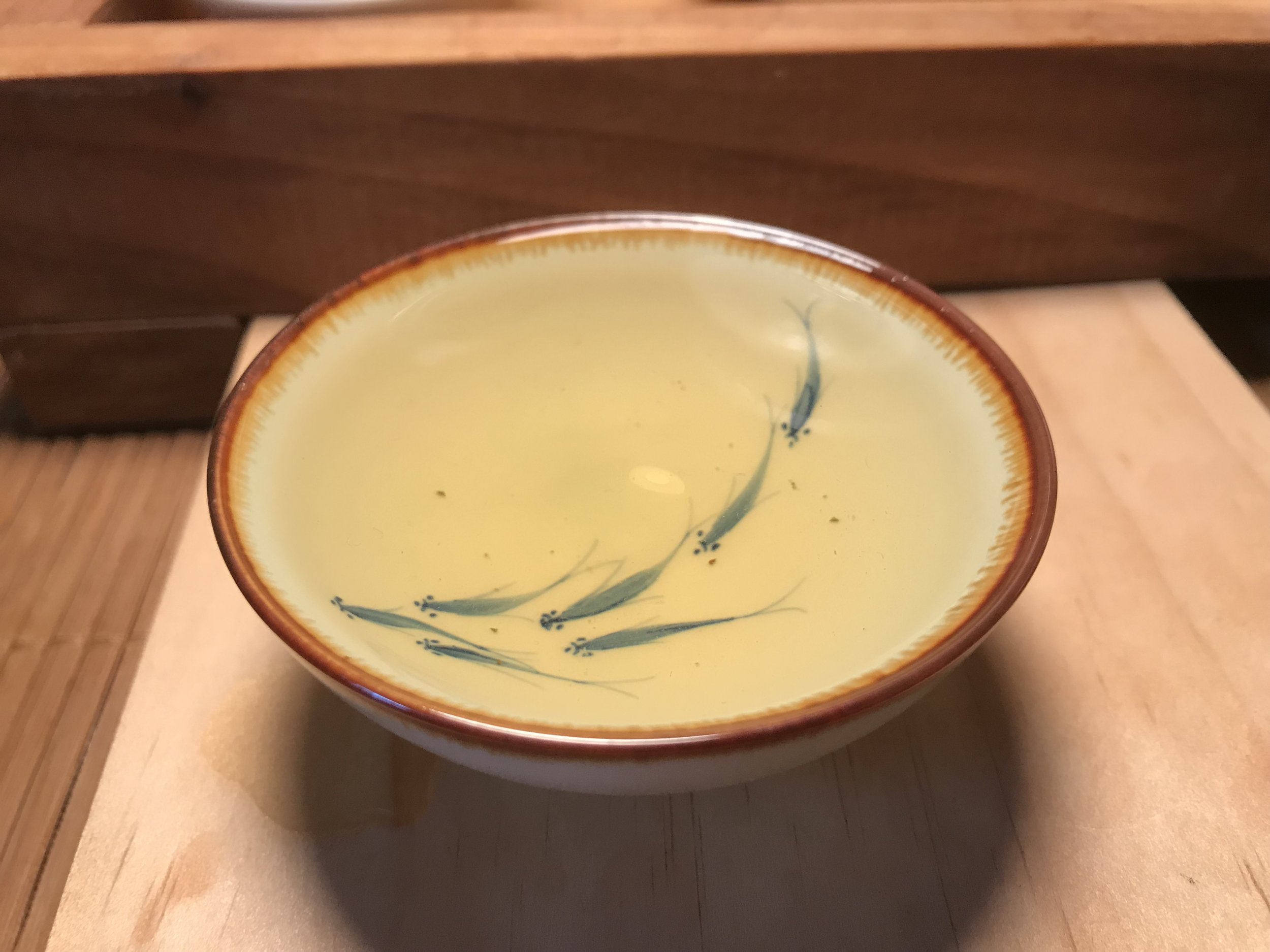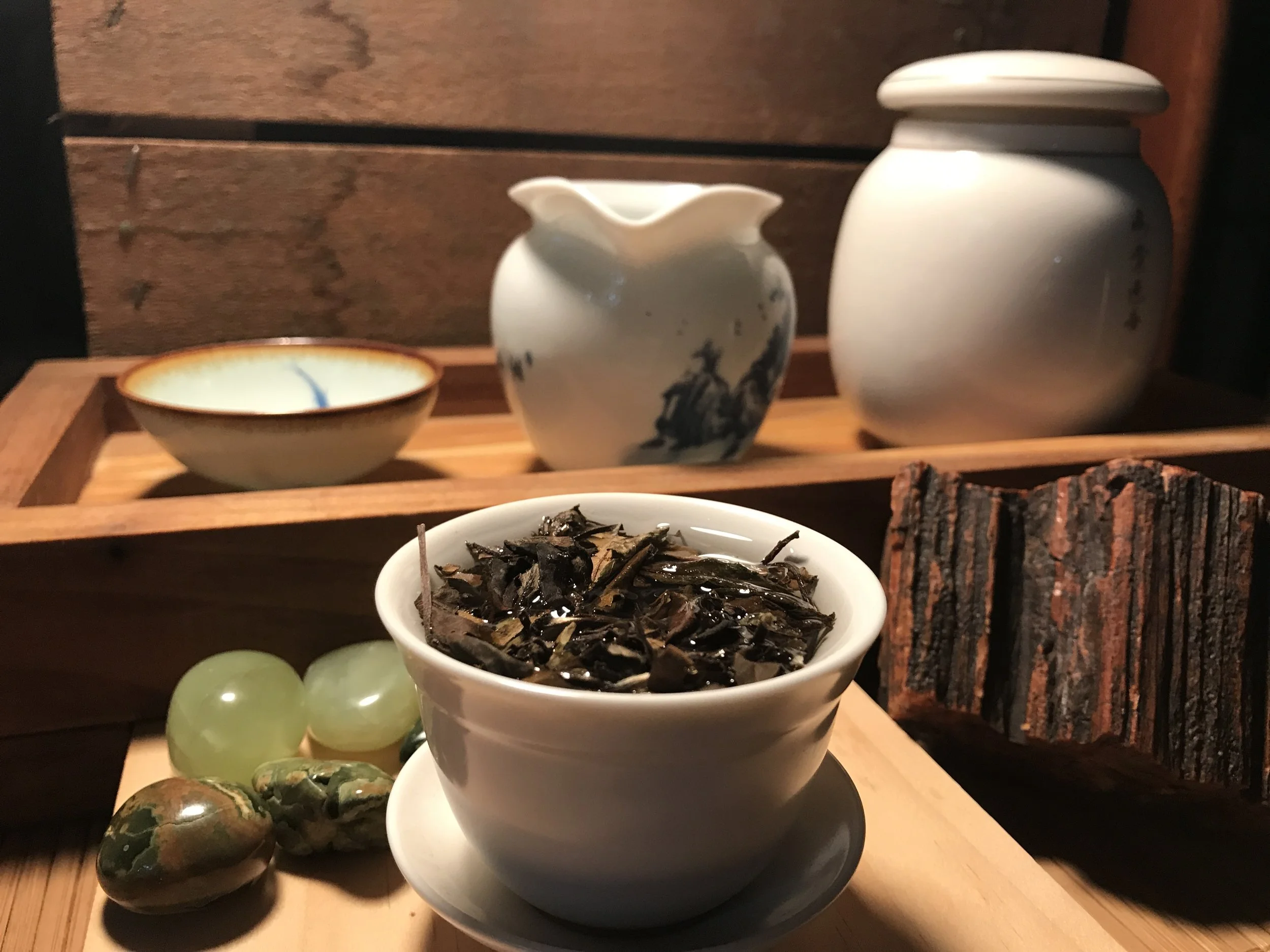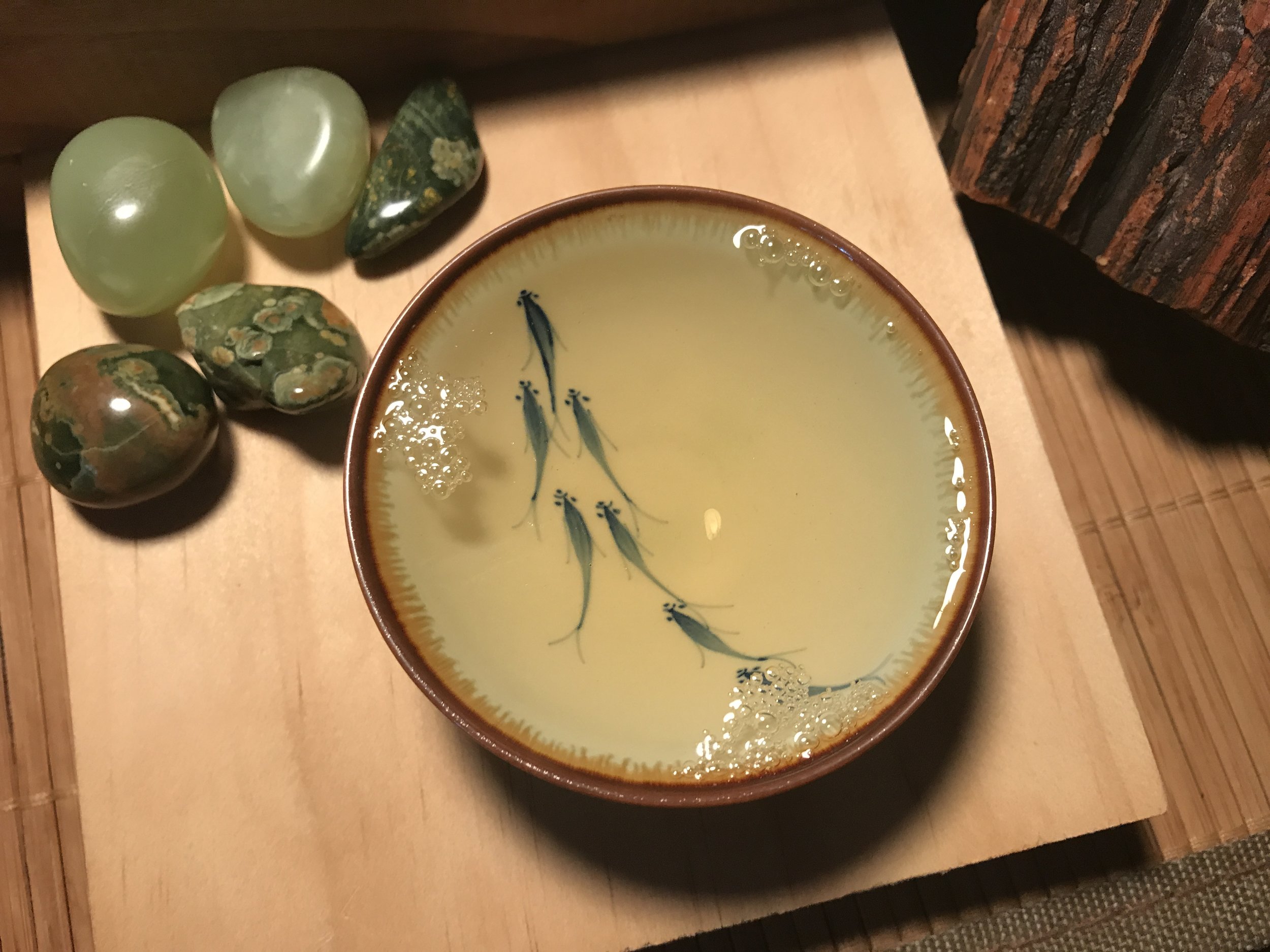Tea Sessions # 8 Jade Rabbit Raw Pu'er
Tea Sessions #8 Jade Rabbit Raw Pu'er from Crimson Lotus Tea.
I have been following Crimson Lotus tea on social media for some time now. I really enjoy watching Glen & Lamu’s videos as I like to know more about the tea I am drinking. I also love how passionate they are about Pu’er tea, I can tell it is a passion and a craft they have really cultivated. This is the first tea that I have had from Crimson Lotus. I ordered a 20g sample of Jade Rabbit.
Aroma:
Dry: This is one of those teas that by just smelling the dry leaf I know it’s going to be good. As I open the sample package and inhale I become aware of the classic smokiness that one gets with raw pu’er along with a little bit of spiciness. Just with a whiff of the dry leaf there is qi stimulation into the head as usual and a strong qi sensation at the Yuzhen energy center at the occiput.
Wet: As always with raw pu’er, I love the aroma after the initial wash. The word that describes the aroma of this tea is awakening. It’s aroma is complex and energizing, with a lot of qi stimulation. I experience the usual smokiness but what sticks out the most is an incredible thick, apricot-citrusy sweetness. I initially experience qi stimulation up into the skull, Yuzhen point(at occiput) and a quick burst of energy from The Yuzhen point to the Yin Tang point in between the eyebrows. After the initial upward burst of energy I experience tingling and qi sensation moving back from my tongue, moving strongly down through the throat and into the heart area. This is just from the aroma..
Color
The brewed color is a nice deep amber.
Taste
1st brew ( 200 Degrees, 10 seconds)
As the aroma is complex so is the taste. As I take the first sip, the first thing that comes to mind is the thickness of the tea soup. First I experience sweetness, a citrusy-apricot flavor, a pleasant smoky-bitter taste. At the end of the sip it all combines into one flavor and lingers nicely in the breath. As I prepare the 2nd brew the taste still lingers and shifts from moment to moment. A few seconds sweet, another few bitter and another citrusy-apricot. As I take a few sips I notice the qi rush upwards into the skull, the upper dantian area, and a quick stimulation following the midline of the head from the Yin Tang point to Yuzhen at the base of the occiput. Directly after this sensation, and as the bitterness kicks in, the qi rushes down into the center chest, the middle dantian area. Like the aroma, the qi is thicker and sweeter than other pu’er teas I have talked about in Tea Sessions. The qi feels viscus and thick as it expands and slowly moves around the chest. It feels like honey, slowly swirling around in the chest. As with most tea, the qi eventually descends down through the belly and feet. If you can’t tell yet, I am really enjoying my experience with the Jade Rabbit.
2nd brew (200 Degrees, 15 seconds)
The 2nd brew is still thick, sweet & citrusy. Pleasant bitter tones begin to seep through that are surrounded by a sweetness. The qi stimulation is the same as the first brew but as the extra bitter flavors kick in, the qi stimulation vibrates more through the throat. As before there is a thick qi that circulates in the chest that eventually descends.
3rd brew & beyond (200 Degrees, 15 -25 seconds)
The Jade Rabbit can go for many, many steeps. I am finishing the 5th brew now and preparing the 6th. The flavor is still complex and alternates between citrusy, smoky & and bitter, always with a thick sweetness. The qi stimulation is consistent as well
My thoughts
This tea is expertly and artfully crafted. The Jade Rabbit isn’t just thrown together, it has been mindfully crafted for a specific experience. The complexity of aroma and flavor in this tea is amazing and totally unique. Through each brew there is a thick sweetness that is accompanied by an alternating apricot-citrus flavor, smokiness or a pleasant bitterness. The mixture of flavors in this tea are like sections or progressions in a piece of music. With each sip I experience tension & release, bitter & sweet. The sweetness is the motif that is developed by the other flavors. It is really a pleasure to experience something so well put together.
As a Chinese Medicine & Qigong practitioner, part of my experience of drinking tea is noting each tea's energetic properties and stimulation of qi. To achieve this expanded perception, I do a quick meditation that relaxes the body and expands my awareness. This allows for my perceptual awareness to be more sensitive.
Here are my notes about qi stimulation while drinking the Jade Rabbit:
As with most pu’er, I noticed the initial burst upwards of qi into the center of the skull, which is considered the upper danitan area in Chinese energetic physiology. The upper dantian is located in the skull and can be thought of as the house of spiritual intuition, perception and awareness. It is interesting that I noticed qi stimulation not only in the center of the upper dantian but in the energy points that surround it. I felt a shock of qi rush from the yin tang point, between the eyebrows to the yuzhen point at the base the occiput. These points are also the front and back points of the 6th chakra gate, which is associated with Intellect & spiritual intuition. The upper dantian contains the 6th and 7th chakras gates. Most pu’er teas that I experience activate this center. What was unique about the Jade Rabbit was the shock of qi to the front and back gates and its descent into the chest.
After the initial burst of qi into the upper dantian area, I experienced a slow descent through the throat and into the chest. The chest is considered the middle dantian and generally is considered the seat of transforming mental and emotional energy. Unique to this tea, I felt a slow, thick & sweet energy moving in my chest that eventually descended. I have felt similar sensations with other raw pu’er but this unique in its thickness.
In my opinion this Jade Rabbit invigorates and awakens the intuitive and perceptive nature of the upper dantian while stirring and moving the mental / emotional energies of the middle dantian. It ends up descending down through the belly and legs.
For me the experience of drinking this tea was invigorating to the senses yet so calming and introspective in nature. Because its energetic properties simulate the intuitive & mental emotional energies, this is a great to drink while doing spiritual work & self cultivation.
I am really looking forward to trying other tea’s from Crimson Lotus!
Tea Sessions #6 2015 Litte Walks (Raw Pu'er)
Today I am drinking a gentle basic Pu'er tea that I would classify as a daily drinker. This is a Pu'er from White2Tea.com. Raw pu'er tea is one of my favorite to drink because it can be so complex and intense. The 2015 Little Walks offers a refreshing break from intensity of taste and qi stimulation. It is quite basic and pleasant to drink. I have had this tea for over 2 years and it has mellowed in taste quite a bit.
Leaves:
The tea comes compressed into a cake like many pu'er teas. They are easily separated.
Aroma
Dry : Sweet & Floral
The Dry leaves have a light aroma that is sweet, subtly fruity & floral.The aroma gently stimulates qi in the head and fizzles out over 20 seconds or so. There is also a slight stimulation in the center of chest around the Tanzhong point CV17.
Wet: As I have said in other tea sessions, one of my favorite moments while I am drinking tea is the aroma after the initial wash. The initial wash is to clean and “awaken” the tea. The wet leaf of this 2015 little walks stimulates qi in the head and ripples around towards the back of my ears and eyes. like the dry leaf aroma there is also a little puff of qi movement around in the center of the chest.
Taste
1st brew (200 Degree, 10 seconds)
This raw pu’er tea is very subtle, sweet, floral and a little fruity. The first brew is light and has a nice little floral after taste that lingers on the palate. As I finish the first cup I notice the same qi stimulation as in the wet leaf but more pronounced. It gently activates qi inside of and around the head. The qi stimulation is relaxing and soft feeling, there is a vibration around the temples and ST8 acu point. There is a very subtle vibration behind the eyes too. There is not a major directional push of energy as in the 2016 Harmony Gua. The qi is gently activated and then subsides.
2nd - 3rd Brew (200 Degree, 20 sec)
The second brew is definitely stronger than the first. When it comes to Raw Pu’er tea, I would say that it is still gentle. The dominant flavors are sweet & floral. There is a pleasant, slight bitterness that comes out in steep #2. The qi stimulation is the same as the first brew with a slightly more pronounced descending motion as the bitterness comes out.
Color
The color of the brew is a nice amber color. 2 years ago when I first got this pu’er cake the color of the liquor was bright yellow.
My Thoughts
The 2015 Little Walks from White2Tea is a gentle Raw pu’er tea. It is perfect for someone who doesn’t little the bitter flavor that many other pu’er teas have. The qi stimulation is also quite gentle. There is a simple & noticeable movement of qi in and around the head. It seems to subtly activate qi in the upper dantian, the Gallbladder and stomach meridians around the eyes and temples. There is also a nice fuzzy qi feeling in the chest while drinking this tea. Again, there is no major directional qi movement. This is a great tea if you don’t want a lot of stimulation. It lightly rouses the mind to be awake and the portals of perception (eyes, ears nose, tongue, feeling & clarity of thought) to be sharp. This would be an excellent daily drinker for someone who loves pu’er and doesn’t want to break the bank. The 2015 little walks is a great tea to drink while working, studying or with hanging friends & family. It’s gentleness is perfect for someone who doesn’t like intense teas.
Tea Sessions #5 2016 Qianjiazhai Harmony Xiao Jin Gua (Raw Pu'er)
This is a tea that I really love. I took one sip of it and instantly ordered another cake. This tea is a Raw Pu'er tea. It is a mixture of Spring and Autumn harvests from trees of varying age. Apparently, the age of the trees varies from 300 years old to 1000 years old! It is interesting to note the difference in the taste of Pu'er teas from different aged trees This tea comes from the Qianjiazhai forest in Yunnan, China. I ordered it through one of my favorite tea sources Verdant Tea. This is a well-blended tea that has a great taste and very invigorating qi.
You can order the tea here: 2016 Harmony Gua
Leaves
Like most Pu’er tea, the Harmony Gua, is a tea compressed into a “cake”. The compression is light and I am able to separate the leaves into small chunks without breaking them. The leaves are dark and filled with little silver hairs. I have been aging this tea cake for a little over a year now. The leaves have become more fragrant and darker as it has aged.
Aroma
Dry: Unwrapping the tea cake there is a strong floral aroma that stimulates qi to simultaneously rise up into the head (at the crown Baihui/GV20) and down through the chest into the feet. Interestingly the aroma stimulates the qi in the chest first then simultaneously rises into the skull and descends markedly through the belly to the feet. As the qi descends it slows in the digestive system.
Wet: With Pu’er tea, I love the aroma of the leaves after the first initial wash before drinking it. With this 2016 Harmony Gua that aroma is AWESOME. It is hard to put words on. The aroma is smokey, floral, fruity and spicy all at the same time. The wet aroma invokes a similar qi reaction. It is more forceful with the wet leaf. It strongly shoots upwards to the crown of the head and then descends through the digestive system to the feet. interesting.
Taste
1st brew (200 Degree, 8 seconds)
Sweet, floral & Smokey
As with many Pu’er teas, there is something about the exhale after drinking a cup. This 2016 Harmony Gua leaves a lasting sweet & smokey flavor/aroma in the throat and nose. There is a lot of upward qi stimulation as I drink the first brew. The qi goes all the way up through the skull to the crown of the head. There is a secondary descending motion that I notice that slows in the lower abdomen. It circulates through the bladder and then descends down the inside of the leg to the big toe and bottom of the foot. This energy sensation is felt faster than the feeling the of tea going down the pipes. A minute or two after drinking my final sip of the first brew, the flavor still lingers and feels as if it is a mist rising up into my skull.
2nd (200 Degree, 15 seconds)
Pu’er can be brewed many times. It is usually the 2-4 brew where the flavor is strongest. Normally when I brew this particular tea I look forward to the 2nd brew.
The flavor is FULL. Some bitter tones start to come out in the 2nd brew which is a nice contrast to the sweet and smokey flavor. With the bitter flavor, there is a more descending qi stimulation. The qi still rises up but it strongly comes down. Again a few minutes after drinking my last sip, the nice sweet/smokey flavor lingers.
3rd-5th brew
I brewed this tea many times. Each time the qi was similar. Over time the bitterness becomes more dominant. This tea could probobly go up to 10 brews
Color
The color of the brew is dark yellow/orange.
My Thoughts
When you find a Pu’er that you really like, buy a few cakes of it. There may never be another one quite like it, even from the same trees next year. There are a lot of variables that change the tea year to year. I ordered this last year took one sip and ordered another one. I really like this tea.
In my experience, the 2016 Harmony Gua initially stimulates the qi of the chest, which quickly rises up strongly to the crown of the head and then descends strongly through the digestive system to the feet. The energy center at the top of the head is called BaiHui and is the point where the Pure Yang Qi / Celestial Qi of the heavens is taken into the body. This tea initially stimulates Yang (Quick, warm & activating) Qi. After the initial shoot upwards in, it goes straight down through the digestive system, where it swirls around the intestines and bladder down the inside of the leg to the big toe (spleen meridian) and bottom of the foot.
This downward direction is pretty neat. In my opinion, this tea invigorates (but doesn't build) the qi of the spleen. The spleen’s energetic function( in TCM) is basically the transformation and transportation of the fluids and food essence into useable energy. This is definitely a tea that moves dampness, a condition that affects the spleen's energy matrix. Dampness feels soggy, heavy, slow, foggy and cumbersome. Mentally dampness feels like slow and cloudy thinking. This can be the result of a poor diet and a constitutional tendency towards dampness among many other things. This tea is activating and grounding at the same time. I would say slightly more activating than grounding though. After my 5th brew, I am almost "tea drunk”.
The 2016 Harmony Gua gently wakes up and invigorates energy. It stimulates yang with it's Sweet, Smokey, floral taste and aroma. It grounds that active energy with its slight bitterness that desecneds down to the feet. This is a tea to drink when feeling bogged down or slow, cold, mentally cumbersome and lethargic. It is a good tea for those who feel creatively stuck or those who have a hard time mustering up the energy to get things done. This would also be an excellent tea to drink after a heavy meal.
Tea Sessions #4 Jin Jun Mei
A friend recently hooked me up with this AWESOME tea. She had returned from China a few weeks ago on a Taoist trip. Her group of friends and one of my teachers have a relationship with a tea seller in Beijing. This tea comes from the tea sellers private stash. It is a very high-quality red tea (black tea) called Jin Jun Mei.
When I open the tea jar the leaves smell of honeysuckle in the late summer. Qi expands in the chest around the heart and then descends down through the digestive system.
Leaves
The leaves are large, dark and perfectly intact.
Aroma
Dry Leaf: When I open the tea jar the leaves smell of honeysuckle in the late summer. Qi descends from the head, expands in the chest around the middle dantian and then descends down through the digestive system.
Wet Leaf: The wet leaf smells very sweet and like honeysuckle.
In the cup: The mist that rises off of the liquid is thick and viscous. Its qi goes straight down through the head, chest, and belly.
Taste
1st brew (200 Degree, 10 seconds) Sweet, Malty &Honeysuckle Flower. The sweet flavor remains after drinking the first cup. Similar to the aroma, the energetic movement of the taste descends from the head, through the chest, and into the belly. After the qi moves down through the head it feels like it slows down in the chest. In the chest, there is a puffy vibration as it descends into the belly. After drinking the first cup I literally feel like I've taken a bunch of deep breaths. I feel calm and connected to the earth. Even after a few minutes the sensation and taste remain.
2nd & 3rd brew: In the second brew the sweetness is pronounced and there is a sharpness or clarity that the first brew didn’t have. Interestingly, the energy of the second brew is the same except that initially, I noticed a vibration in glands around my throat and thyroid area. Very unique as I haven’t noticed that sensation with any other teas.
Color
The color of the brew is beautiful dark amber.
My Thoughts
I feel really lucky to have stumbled upon this tea as I've never had such a high-quality Jin Jun Mei. This is a tea I will drink all day long until the decoction is clear and has released all of its essence. The energetics of this Jin Jun Mei, at least in my experience, is unique in that it affects all three dantians. Upper, Middle & Lower. The directionality is descending from upper dantian, through the middle and into the lower. This means that the energetic nature of this tea will support grounding the mind and the heart. Grounding the mind and the heart is experienced as the settling of the mind and emotions. In this state, one is present and receptive. As mentioned above it has a particular affinity for the middle dantian which contains the organ systems of the heart and lungs. Similar to the Xue Wu Ye Dang in tea sessions #3, the energy of this tea moves the qi in the heart and lungs. I would say that the Jin Jun Mei has more of an affinity for the heart though. After taking a sip the qi moved from the head into the chest where it slowed down before going into the belly. This is a tea to drink when feeling like you are in the clouds / stuck in your head or overwhelmed with thoughts or desire. It brings qi down from the head and grounds you into the earth with a pronounced heart qi action on the way down.
If I put the qi of this tea into words it would be something like “ Chill, I got you man. Everything is going to be Ok, Lets enjoy this moment as we’re not promised the next one”
This is a perfect tea for someone like me whose energetic nature is to be in the clouds. It will show you what it feels like to stay connected to the heavens but strongly rooted into the dense material realm of the earth.
Tea Sessions Vol. 3 Xue Wu Ye Dancong
Welcome back to Tea Sessions!
Today I will be sharing my experience drinking an oolong tea called Xue Wu Ye Dancong. The tea itself is produced by a tea master named Huang Rui Guang. It was grown in China in Wudong Shan. I bought it through Verdanttea.com, which is one of my favorite tea sellers.
Leaves
The leaves are whole, large and dark green.
Aroma
Dry Leaf: Flowers, sweet. I instantly notice, just by simply smelling the dry leaves, a qi sensation running up into the center of my head and down into my chest. The sensation in my chest swirls around the area of what we call in Chinese Medicine the Middle Dantian. The Middle Dantian is located in the chest and is an internal repository that transforms mental and emotional energy. The heart, its qi, and functions are related to the middle dantian.
Just getting a whiff of the aroma of the dried leaves, I know this is going to be good.
Wet Leaf: the aroma of the wet leaf is even more floral. the aroma reminds me of the honeysuckle in the evening during summer & of the smell of citrus fruits flowers. The Qi Swirls into my chest and head.
Xue Wu Ye Dangcong brewing in a gaiwan.
Taste
1st brew (200 Degree, 10 seconds) Sweet, Vegetal, Honeysuckle Flower. The floral taste remains in my mouth and throat after drinking it. There is a very clear and strong qi sensation in the chest/Middle dantian area. Heart & Lungs.
2nd & 3rd brew: With most oolong teas the second and third brews are the best. By this time the tea leaves have opened up and released most of its essence into the water. The Xue Wu Ye Dancong is no exception. The second and third brew are even more floral, still sending qi vibrations into the chest. The nice flavor lingers in the mouth. While I am breathing I can even smell the floral aroma of this tea in my nose.
Color
The color of the brew is a dark yellow
My Thoughts
This is a really pleasant tea. It is enjoyable in all aspects: Leaves, aroma, taste and energy. Xue Wu Ye Dancong, in my opinion, is a tea that calms the shen (mind/spirit) and moves emotion. As I said before I felt qi primarily swirling in my chest and secondarily in my head. This is the area of the Middle Dantian (chest) which acts as a repository that transforms mental and emotional energy. After drinking this tea I notice that my chest feels lighter and more expanded. The floral energy of this tea cuts thruogh the heaviness of stagnation in the middle dantian. This is a tea to drink when feeling stuck emotionally. In particular, the emotions associated with the heart & lungs.
Heart: anxiety, nervousness, agitation, over-excitement.
Lungs: grief, sadness, guilt & despair.
I would enjoy drinking this tea anytime. If I wanted to use it for its energetic qualities I would personally drink this tea when feeling melancholy, “down" or sad. This would be a perfect tea to drink after being disappointed or let down. It would also be great in the aftermath of making a mistake. This tea supports the lung energy and will help one reflect and take responsbility for ones actions.
If you want to try this tea here is the link:
Tea Sessions Vol. 2 2016 Shou Mei
Welcome to Tea Sessions Vol. 2
My son is down for a nap and I have some business development work here on my schedule. What better time to than have some tea! Ha!
Seriously though, drinking tea, gong fu style is a mindfulness practice for me. It helps me become focused and aware of what's going on around me and in my own mind. That said, the tea I am drinking today is a tea from one of my favorite sources. Verdant Tea. I appreciate how Verdant gives a lot of information about the tea they sell. Each tea has a page to itself describing where its from, tasting notes, how its grown and who grew it. I love to get to know the farmers and they're personal philosophies about tea. I am drinking a White tea today called Shou Mei .
Before Starting, here are a few lines of poetry I wrote based off of the Zen Buddhist Meal Gatha. Reciting this before drinking tea allows me to have more appreciation, awareness and purpose during my tea session.
The Shou Mei I am drinking is from 2016. It is grown in Hulin, Fuding, Fujian province by the Wang family. This type of white tea is picked later in the season and is leaf only (no buds). It is quite unique from other white teas. I brew shou mei every now and then when I want something different.
The moment I open the tea jar, I get a very strong tobacco & earthy like smell. I get Sensations of qi moving downwards through the center of the body into the belly. There is a particularly strong qi sensation for me around the throat. Its very different from the Bai Mu Dan in Tea Sessions Vol. 1, which had a lot of rising qi.
Brew #1 200 degrees, 6 seconds
The liquid is Dark Yellow. It is sweet and Tobacco-like. There is almost no rising sensation. There is strong qi sensation at the Tanzhong energy point (center of the chest) , Zhongwan (in between navel and sternum) and the Belly at Duqi (navel area). The taste reminds me of the smell of Autumn. It is intense but doesn't linger like the Bai Mu Dan.
Brew #2 200 Degrees, 8 seconds
The taste continues to be sweet and tobacco like. The qi sensations still descend down into the belly.
Brew #3 200 Degrees 10 seconds
The third brew is lighter. Still Tobacco-like and descends.
This is a really unique and different tea. Interestingly for a white tea, the qi of Shou Mei has a descending action. In my opinion it resonates with the heart, stomach and spleen energy systems. It is unique in the white tea category as most white teas I drink have rising actions that open up the qi of the chest and head. This is a tea to drink in the late summer and Autumn. It is a tea that will calm the mind and give you a sense of being rooted. The sweet tobacco-like taste is very earthy. Brewing Shou Mei would be good with: Friends, when you feel scattered and need some 'grounding', outside in Autumn, after a light meal, contemplation and putting into words your ideas or realizations.
Tea Sessions Vol. 1 Bai Mu Dan (White Peony) White Tea
Welcome to Volume 1 of Tea Sessions
Drinking Chinese tea has become a way of life for me over the past 12 years. It began when I moved to Boston in 2005. I found a tea store on Newbury St. called Tealuxe and from there I was hooked. I was surprised to experience the effects drinking tea (camellia sinensis) had on my mind and body. I began to explore the vast world that is tea and it's alchemy. After years of exploring tea, it helped lead me into becoming a practitioner of Chinese medicine. Today I drink tea as a meditation, medicine, a catalyst for creativity and a still mind. If you know me, you know I drink a lot of tea and love to share it.
This on-going series about my adventures with tea is for all of my family, friends and patients who want to know more about tea culture, tea varieties and it's energetic impact on body and mind.
Let's start with the tea I am drinking right now.....
Bai Mu Dan (White Peony) White Tea
The first tea I will share with you is one that I have been really enjoying lately. It is a type of white tea called "Bi Mu Dan", Which means "White Peony". White tea is the least processed of all Chinese teas, all of which come from the Camelia Sinensis plant. The wide varieties of tea come about from different processing technique, where it is grown, different cultivation techniques and varietals. For white tea, the leaves are picked and then spread out to dry. Bi Mu Dan is made by plucking a fresh tea shoot along with two young leaves.
This Bai Mu Dan is from a tea seller called Yunnan Sourcing the tea is called "Fuding White Peony Bai Mu Dan".
here is the link: "Fuding White Peony Bai Mu Dan"
Before a tea session I bring my mind into a meditative or qi gong state. This allows me to have a deeper experience of myself and the energetic effects of the tea I am drinking. To be able to sense qi/energy or have a deeper than usual experience of something, I know that I must "tune" my mind into a certain state. You can think of it like tuning to a particular radio station. If you want to hear the music of a certain radio station you must tune into its frequency.
The environment is calm. The windows are open, bringing fresh air into my office. I believe that tea is always better experienced with as much natural energy around as possible. I have the beautiful "Chant of Metta" (the chant of loving kindness) by Imee Ooi playing in the background.
Today I am brewing my tea in a gaiwan or "lidded cup"as I feel that I can experience the nuances of each brew better. For white tea I fill the gaiwan about half way with leaves.
The tea leaves and buds are furry, silver and green . Just opening the container the aroma of the raw leaves is fresh and light.
First brew 185° water , 15 Seconds
The taste is sweet fresh and light. It's fragrance lingers after I drink it, like a sweet mist permeating through my chest up into my head . There is qi sensation in my chest, throat, tingling at the yuzhen energy center at the occiput and around the crown of the head. On my exhale I can still smell it and feel the mist coursing through my lungs and upper body.
Second brew 185° water , 20-30 Seconds
The second brew still sweet and fresh much like the first. The soup is thicker this time around but still has the sweet fresh fragrance. The qi moves through the chest, lungs and head.
Third brew 185° water , 30 Seconds
The taste is still sweet however the slightly bitter tones are beginning to come out. In this brew the energy of the qi is kicking in strong. I feel a rush of energy to the center of my head and mental clarity is strong. Another brew might put me over the edge of cha dzui (Tea Drunk) . There is also a sensation at yin tang ( energy point in between eyes).
This tea is definitely one that clears the energy of the head and chest. In my opinion it's energetic nature is sweet, slightly bitter and cooling. In Chinese Herbal medicine we say that the leafy herbs tend to ascend while the dense roots and barks tend to descend. I definitely feel the ascending nature as I drink this tea. This is not the tea that I would drink after a heavy meal but one that I would drink to calm & focus my mind. Drink this tea for meditation, reading spiritually nourishing material , having nourishing conversation with friends, or to do creative work.
If this inspires you to drink a great cup of tea.. GREAT! I believe that tea is a powerful medicinal herb and catalyst for appreciating nature and meditation. Let me know how you experience this tea!


